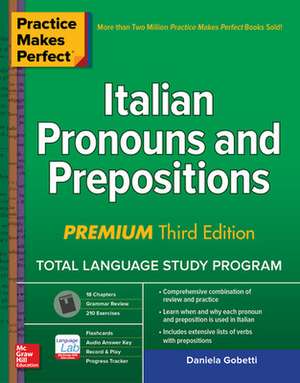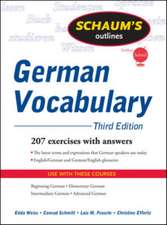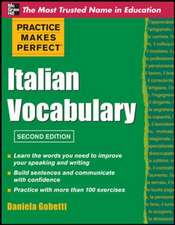Practice Makes Perfect: Italian Pronouns and Prepositions, Premium Third Edition
Autor Daniela Gobettien Limba Engleză Paperback – 21 iul 2019
Build your Italian language skills and communicate with confidence
Based on the successful approach of the Practice Makes Perfect series, this accessible guide offers a clear and engaging presentation of all aspects of Italian pronouns and prepositions. This updated edition provides clear explanations of the usage of these two essential elements of grammar along with practical examples illustrating and clarifying each point. You’ll find a variety of exercises for plenty of practice. An answer key at the back of the book offers immediate feedback.
For added practice and study on-the-go, this edition features review quizzes via the exclusive McGraw-Hill Education Language Lab app. Audio recordings of the answer key for more than 100 exercises let you check your progress and your pronunciation skills.
Practice Makes Perfect: Italian Pronouns and Prepositions will help you:
•Learn the subtleties of how to use pronouns and prepositions
•Build your language skills using more than 120 engaging exercises
•Reinforce your knowledge with everyday examples covering a wide range of topics
•Study on-the-go with audio recordings and review quizzes via the McGraw-Hill Education Language Lab app
•Develop better pronunciation, and more
Preț: 134.20 lei
Preț vechi: 156.74 lei
-14% Nou
Puncte Express: 201
Preț estimativ în valută:
25.68€ • 26.65$ • 21.47£
25.68€ • 26.65$ • 21.47£
Carte tipărită la comandă
Livrare economică 14-25 martie
Livrare express 11-15 februarie pentru 54.02 lei
Preluare comenzi: 021 569.72.76
Specificații
ISBN-13: 9781260453478
ISBN-10: 1260453472
Pagini: 256
Dimensiuni: 213 x 272 x 13 mm
Greutate: 0.52 kg
Ediția:3
Editura: McGraw Hill Education
Colecția McGraw-Hill
Locul publicării:United States
ISBN-10: 1260453472
Pagini: 256
Dimensiuni: 213 x 272 x 13 mm
Greutate: 0.52 kg
Ediția:3
Editura: McGraw Hill Education
Colecția McGraw-Hill
Locul publicării:United States
Cuprins
Preface
Part I Pronouns
Unit 1 Subject Pronouns
Pronouns and Conjugations
Addressing People: Tu/Voi, Lei/Loro
Esso (It) as Subject
Placement in Negative Clauses
When to Use Subject Pronouns
Unit 2 Direct Object Pronouns
Formal and Informal Address
Placement in Negative Clauses
Placement with the Infinitive
Placement with the Imperative
Direct Object Pronouns with Compound Tenses (Tempi Composti)
Placement with Modal Auxiliaries (Verbi Servili)
Lasciare and Fare + the Infinitive
Lo (It/That)
Ci (Vi): Other Uses
Unit 3 Indirect Object Pronouns
Placement of Strong Forms in Affirmative and Negative Clauses: a me (to Me)/a voi (to You), etc.
Placement of Weak Forms in Affirmative and Negative Clauses: mi (to Me), ti (to You), gli (to Him), etc.
Placement with the Infinitive
Placement with the Imperative, Second Person Singular and Plural
Indirect Object Pronouns with Compound Tenses
Placement with Modal Auxiliaries (Verbi Servili)
Causative Verbs (Verbi Causativi): Lasciare, Fare
Indirect Object Pronouns with Piacere (to Please)
Unit 4 Double Pronouns
Placement of Double Pronouns
Double Pronouns with Compound Tenses
Placement with Modal Auxiliaries (Verbi Servili)
Causative Verbs (Verbi Causativi): Lasciare, Fare
Unit 5 Reflexive Pronouns and Si as Impersonal Pronoun
Placement with the Imperative (Second Person Singular and Plural), the Infinitive, and the Gerund
Compound Tenses
Reflexive Pronouns and Direct Objects
Doing Things for Oneself
Coordination of the Reflexive Pronoun with the Auxiliary and the Past Participle
Reciprocal Reflexive Verbs (Verbi Riflessivi Reciproci)
Reflexive Verbs and Direct Object Pronouns
Si as Impersonal Pronoun
Unit 6 The Pronoun Ne
Ne (of/by Someone/Something)
Placement of Ne
Ne (of This, of That/from This, from That)
Ne as Partitive Pronoun (Pronome Partitivo)
Ne and Gender/Number Coordination
Ne and Double Pronouns
Ne and Reflexive Pronouns
Unit 7 Pronouns as Objects of Prepositions
Placement
Unit 8 Interrogative Pronouns
Chi? (Who?/Whom?)
Chi as Subject
Chi as Direct Object
Che?/Cosa?/Che Cosa? (What?)
Qual(e)? (What?) and Quali? (Which?)
Quanto?/Quanta?/Quanti?/Quante? (How Much/How Many?)
Unit 9 Relative Pronouns
Che (Who, Whom, That, Which)
Cui (to Whom, by Whom, Through Which, etc.)
Variable and Invariable Relative Pronouns
Dove (Where) and Quando (When) as Relative Pronouns
Unit 10 Demonstrative Pronouns
Questo (This) and Quello (That)
Unit 11 Possessive Pronouns
A Friend of Mine, of Yours, etc.
Mio (My) and Il Mio (Mine)
Unit 12 Indefinite Pronouns
Double Negatives
Gender and Number
Molti (Many) and Tanti (So Many)
Indefinite Pronouns + Ne
Indefinite Pronouns + Di (Among)
Indefinite Pronouns That Refer Only to Things
Tanto... (So/As Much... ) and Quanto (So/As)
Part II Prepositions
Unit 13 The Most Commonly Used Prepositions
Other Parts of Speech That Function as Prepositions
What Is a Preposition?
Prepositional Locutions
Prepositions and Subordinate Clauses
Classification of Prepositions
Unit 14 Possession and Specification
su (on),
Part I Pronouns
Unit 1 Subject Pronouns
Pronouns and Conjugations
Addressing People: Tu/Voi, Lei/Loro
Esso (It) as Subject
Placement in Negative Clauses
When to Use Subject Pronouns
Unit 2 Direct Object Pronouns
Formal and Informal Address
Placement in Negative Clauses
Placement with the Infinitive
Placement with the Imperative
Direct Object Pronouns with Compound Tenses (Tempi Composti)
Placement with Modal Auxiliaries (Verbi Servili)
Lasciare and Fare + the Infinitive
Lo (It/That)
Ci (Vi): Other Uses
Unit 3 Indirect Object Pronouns
Placement of Strong Forms in Affirmative and Negative Clauses: a me (to Me)/a voi (to You), etc.
Placement of Weak Forms in Affirmative and Negative Clauses: mi (to Me), ti (to You), gli (to Him), etc.
Placement with the Infinitive
Placement with the Imperative, Second Person Singular and Plural
Indirect Object Pronouns with Compound Tenses
Placement with Modal Auxiliaries (Verbi Servili)
Causative Verbs (Verbi Causativi): Lasciare, Fare
Indirect Object Pronouns with Piacere (to Please)
Unit 4 Double Pronouns
Placement of Double Pronouns
Double Pronouns with Compound Tenses
Placement with Modal Auxiliaries (Verbi Servili)
Causative Verbs (Verbi Causativi): Lasciare, Fare
Unit 5 Reflexive Pronouns and Si as Impersonal Pronoun
Placement with the Imperative (Second Person Singular and Plural), the Infinitive, and the Gerund
Compound Tenses
Reflexive Pronouns and Direct Objects
Doing Things for Oneself
Coordination of the Reflexive Pronoun with the Auxiliary and the Past Participle
Reciprocal Reflexive Verbs (Verbi Riflessivi Reciproci)
Reflexive Verbs and Direct Object Pronouns
Si as Impersonal Pronoun
Unit 6 The Pronoun Ne
Ne (of/by Someone/Something)
Placement of Ne
Ne (of This, of That/from This, from That)
Ne as Partitive Pronoun (Pronome Partitivo)
Ne and Gender/Number Coordination
Ne and Double Pronouns
Ne and Reflexive Pronouns
Unit 7 Pronouns as Objects of Prepositions
Placement
Unit 8 Interrogative Pronouns
Chi? (Who?/Whom?)
Chi as Subject
Chi as Direct Object
Che?/Cosa?/Che Cosa? (What?)
Qual(e)? (What?) and Quali? (Which?)
Quanto?/Quanta?/Quanti?/Quante? (How Much/How Many?)
Unit 9 Relative Pronouns
Che (Who, Whom, That, Which)
Cui (to Whom, by Whom, Through Which, etc.)
Variable and Invariable Relative Pronouns
Dove (Where) and Quando (When) as Relative Pronouns
Unit 10 Demonstrative Pronouns
Questo (This) and Quello (That)
Unit 11 Possessive Pronouns
A Friend of Mine, of Yours, etc.
Mio (My) and Il Mio (Mine)
Unit 12 Indefinite Pronouns
Double Negatives
Gender and Number
Molti (Many) and Tanti (So Many)
Indefinite Pronouns + Ne
Indefinite Pronouns + Di (Among)
Indefinite Pronouns That Refer Only to Things
Tanto... (So/As Much... ) and Quanto (So/As)
Part II Prepositions
Unit 13 The Most Commonly Used Prepositions
Other Parts of Speech That Function as Prepositions
What Is a Preposition?
Prepositional Locutions
Prepositions and Subordinate Clauses
Classification of Prepositions
Unit 14 Possession and Specification
su (on),














